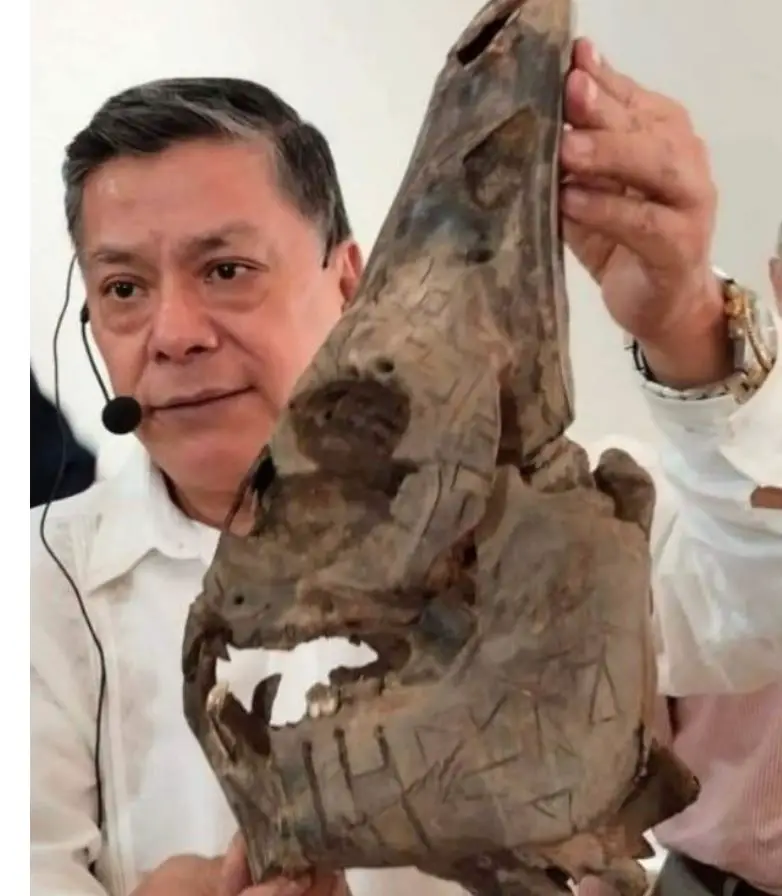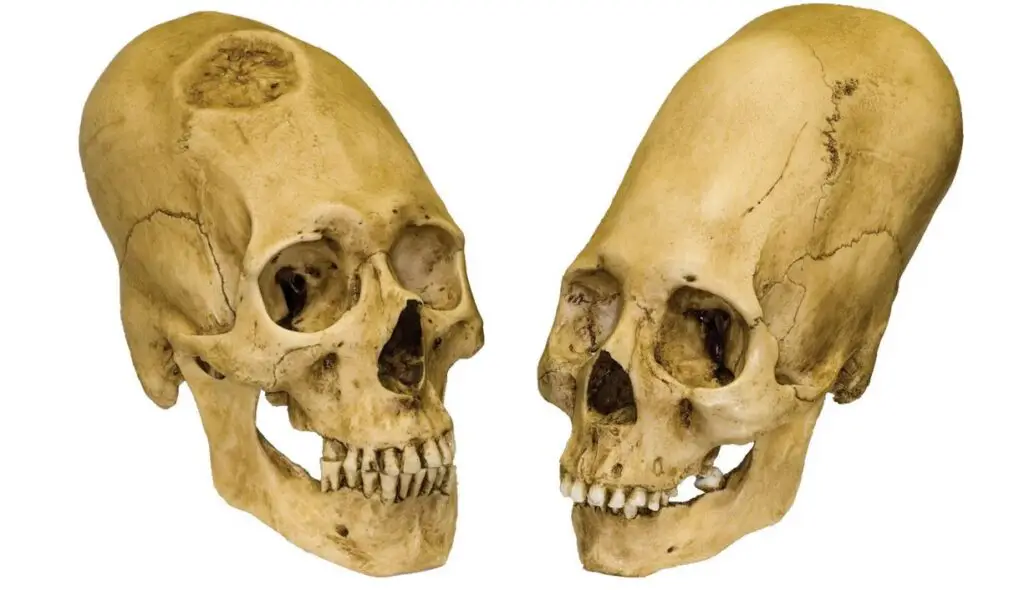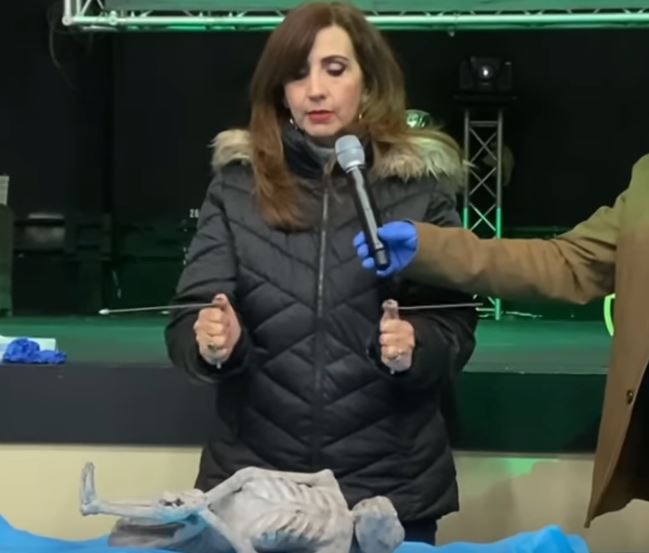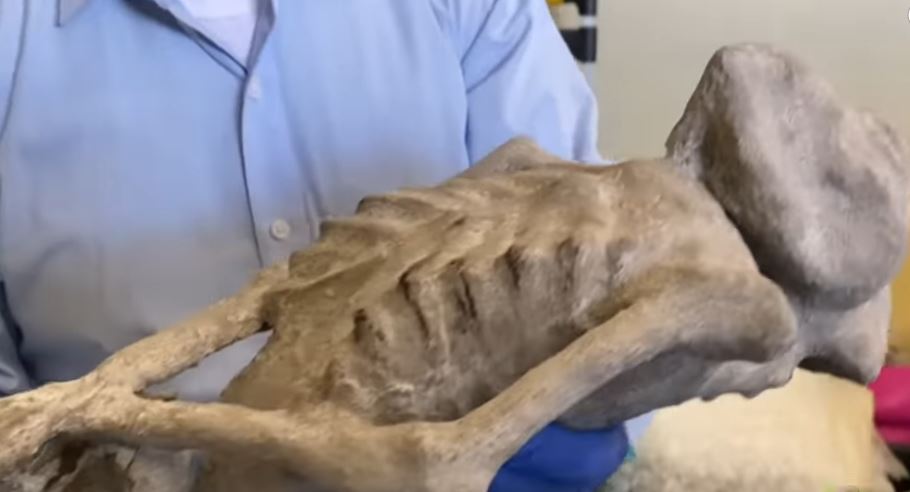Podcast: Play in new window | Download
Subscribe: Apple Podcasts | RSS
 The Teatro de la Ciudad in the border city of Tecate, Baja California, played host to “The World UFO Fest” during the second weekend of November 2022. The conference featured UFO experts from throughout Mexico and the world who attended to share their knowledge about the ever-expanding field of UFOs. A former Mexican military doctor named Pablo Enrique García Sánchez brought several interesting items to his presentation. Two of the items were unusual skulls, one with strange carvings on its surface. The other item the doctor brought, though, had people lining up after the lecture to take selfies with it and to examine it up close. It was the gray-colored mummified remains of a creature in a crouching position, perfectly preserved, with long and skinny arms and legs and an elongated head. The creature was male and had only four fingers and four toes. It looked humanoid but at the same time looked like nothing ever seen before on earth. Dr. García explained during his presentation that the creature when alive stood 90 centimeters tall, which is a little under 3 feet tall. The most dramatic part of the lecture took place when Mexican psychic Taliesa Majar, clad in a cold weather parka, took to the stage with her metal divining rods to read the energy coming from the mummy. The metal rod in her right hand began swirling uncontrollably which Taliesa interpreted to mean that the mummy was creating an energy vortex. After this energy demonstration, the lines to the front of the lecture hall resumed with curious people eager to get a closer look. Pablo García even gave a name to this object of curiosity: Citlaltemini. In Nahuatl, the language of the Aztecs, the name Citlaltemini means “Star Brother.”
The Teatro de la Ciudad in the border city of Tecate, Baja California, played host to “The World UFO Fest” during the second weekend of November 2022. The conference featured UFO experts from throughout Mexico and the world who attended to share their knowledge about the ever-expanding field of UFOs. A former Mexican military doctor named Pablo Enrique García Sánchez brought several interesting items to his presentation. Two of the items were unusual skulls, one with strange carvings on its surface. The other item the doctor brought, though, had people lining up after the lecture to take selfies with it and to examine it up close. It was the gray-colored mummified remains of a creature in a crouching position, perfectly preserved, with long and skinny arms and legs and an elongated head. The creature was male and had only four fingers and four toes. It looked humanoid but at the same time looked like nothing ever seen before on earth. Dr. García explained during his presentation that the creature when alive stood 90 centimeters tall, which is a little under 3 feet tall. The most dramatic part of the lecture took place when Mexican psychic Taliesa Majar, clad in a cold weather parka, took to the stage with her metal divining rods to read the energy coming from the mummy. The metal rod in her right hand began swirling uncontrollably which Taliesa interpreted to mean that the mummy was creating an energy vortex. After this energy demonstration, the lines to the front of the lecture hall resumed with curious people eager to get a closer look. Pablo García even gave a name to this object of curiosity: Citlaltemini. In Nahuatl, the language of the Aztecs, the name Citlaltemini means “Star Brother.”
This recent news of alien mummy is not to be confused with two other famous claims of alien mummy discoveries. One very well-known discovery involved renowned Mexican paranormal investigator Jaime Maussan, who has spent the better part of 50 years reporting on UFO-related topics. Maussan had a photographic slide of an alleged alien mummy that was supposedly taken some time in the late 1940s in New Mexico. It was revealed and examined at a conference in Mexico City in 2015. More skeptical investigators sharpened up the image with modern technology and figured out that this supposed alien body was really the mummy of a young boy that was removed from one of the cliff dwellings at Mesa Verde in 1894 and made its way to a museum at Mesa Verde National Park in 1938. The slide was taken by someone on vacation to the park sometime in the 1940s. Although it was nicknamed “The Roswell Slide,” it had nothing to do with the famous New Mexico flying saucer incident of 1947. This alien mummy story was easily debunked by anti-blurring photographic technology. The second alien mummy story that could be confused with García’s Citlaltemini comes from the Nazca region of Peru, and not Mexico. In a crouching position much like the Mexican mummy, the Peruvian one was much larger and generated quite a buzz when it was shown to the world in a video that debuted on Gaia TV on June 20, 2017. This supposed mummy had only 3 fingers and it had a large, elongated head. While cranial deformation was common in many ancient cultures of the Americas, this mummy had an especially long skull that seemed to be more naturally occurring rather than being created by deliberate deformation in infancy or early childhood. The discovery of  this alleged mummy took place near the famous Nazca Lines, an arid area of southern Peru where complicated geometrical patterns and pictures of animals and people are carved onto the surface of the earth. The Nazca Lines have long been associated with many “Ancient Astronauts” theories and the supposed discovery of the strange Nazca mummy played into the whole alien visitation narrative. The mummy was later declared a hoax by several scientists who claimed that it was assembled from the remains of several different ancient Peruvian mummies and put together with a papier-maché-like plaster substance. When the Nazca mummy first made its rounds, a Mexican forensic researcher who was trained as a physician at Mexico’s Naval Medical School named José de Jésus Zalce Benitez declared that “the existence of the three fingers of the mummy makes us think that this does not belong to a human species.” Dr. Zalce, ironically, also had a hand in authenticating the previously mentioned mummified boy as seen on the so-called “Roswell Slide,” which also was debunked. So far, this famous Mexican forensic researcher has not been called in to work on the latest supposed extraterrestrial mummy, Dr. García’s Citlaltemini.
this alleged mummy took place near the famous Nazca Lines, an arid area of southern Peru where complicated geometrical patterns and pictures of animals and people are carved onto the surface of the earth. The Nazca Lines have long been associated with many “Ancient Astronauts” theories and the supposed discovery of the strange Nazca mummy played into the whole alien visitation narrative. The mummy was later declared a hoax by several scientists who claimed that it was assembled from the remains of several different ancient Peruvian mummies and put together with a papier-maché-like plaster substance. When the Nazca mummy first made its rounds, a Mexican forensic researcher who was trained as a physician at Mexico’s Naval Medical School named José de Jésus Zalce Benitez declared that “the existence of the three fingers of the mummy makes us think that this does not belong to a human species.” Dr. Zalce, ironically, also had a hand in authenticating the previously mentioned mummified boy as seen on the so-called “Roswell Slide,” which also was debunked. So far, this famous Mexican forensic researcher has not been called in to work on the latest supposed extraterrestrial mummy, Dr. García’s Citlaltemini.
Dr. García has only recently been making the rounds with his “Star Brother” mummy trying to get help with his investigation. The good doctor is very careful not to label the mummy “alien” or “extraterrestrial,” although the name he gave the mummy – Citlaltemini, or “Star Brother” – would lend itself to off-worldness. García prefers to call it an “unknown biological entity.” As of this recording, no formal analysis has yet been made of this mummy. No one has offered to x-ray it or take samples of it for testing. Perhaps given the recent alien mummy hoaxes, no one considered “scientifically credible” is willing to put their reputation on the line to take part in the mummy’s examination. Although he may lack the testing equipment, García does not lack a long history of awards and accolades. In addition to being a medical doctor, he holds two other degrees from state colleges in Morelos and Guerrero. The doctor has also been awarded many prizes and awards from various branches of the Mexican government and military to recognize his contributions and services. Dr. García’s latest honor was the Golden Microphone Award given to him in December of 2022 by the Cámara de Deputados, or Chamber of Deputies, in Mexico City for his many decades of work in archaeology, specifically with his work in trying to describe and classify the ancient Mezcaliengena culture of the southern part of central Mexico. Many people cite Pablo García’s long resume when trying to make a case against the mummy being a hoax.
 As a somewhat professional archaeologist, Dr. García claims to have found the mummy in the context of an archaeological dig. In an unknown location on private property somewhere between the city of Taxco and the town of Mezcala in the state of Guerrero, García and a colleague were digging on a side of a hill that looked like a natural pyramid. Many cut-and-paste internet sources repeat the notion that the mummy was found in an abandoned silver mine, but according to his own lecture at the World UFO Fest in Tecate, García states it was a fresh archaeological dig. Inside this pyramid-shaped hill was a small series of tunnels, and inside those tunnels were three chambers that held three stone coffins. Two of these sarcophagi were badly damaged along with their contents, but the third one contained the intact mummy that García is now bringing to conferences. He is claiming that the artifacts uncovered in and around these tunnels date the mysterious archaeological site to between 2,000 and 3,000 years old, although Dr. García never explains how he has arrived at this conclusion without the equipment to make the proper tests. He claims that the site in which the mummy was found is part of that Mezcaliengena Culture that he is credited with identifying and studying for many years. Those who are established scholars in the field of archaeology in Mexico, including the National Institute of Anthropology and History, or INAH, do not recognize any distinct ancient culture corresponding to what García is calling the Mezcaliengena. At the Tecate conference García claimed to have gone to universities and scientific institutions in 20 different states in Mexico and had no luck in getting anyone to help him with conducting serious analysis on the mummy or the supposed alien skulls and skull fragments he has in his possession. Although the mummy has not been subjected to x-rays, Dr. García claims that it still has all of its internal organs intact which would be a boon to researchers if examined properly.
As a somewhat professional archaeologist, Dr. García claims to have found the mummy in the context of an archaeological dig. In an unknown location on private property somewhere between the city of Taxco and the town of Mezcala in the state of Guerrero, García and a colleague were digging on a side of a hill that looked like a natural pyramid. Many cut-and-paste internet sources repeat the notion that the mummy was found in an abandoned silver mine, but according to his own lecture at the World UFO Fest in Tecate, García states it was a fresh archaeological dig. Inside this pyramid-shaped hill was a small series of tunnels, and inside those tunnels were three chambers that held three stone coffins. Two of these sarcophagi were badly damaged along with their contents, but the third one contained the intact mummy that García is now bringing to conferences. He is claiming that the artifacts uncovered in and around these tunnels date the mysterious archaeological site to between 2,000 and 3,000 years old, although Dr. García never explains how he has arrived at this conclusion without the equipment to make the proper tests. He claims that the site in which the mummy was found is part of that Mezcaliengena Culture that he is credited with identifying and studying for many years. Those who are established scholars in the field of archaeology in Mexico, including the National Institute of Anthropology and History, or INAH, do not recognize any distinct ancient culture corresponding to what García is calling the Mezcaliengena. At the Tecate conference García claimed to have gone to universities and scientific institutions in 20 different states in Mexico and had no luck in getting anyone to help him with conducting serious analysis on the mummy or the supposed alien skulls and skull fragments he has in his possession. Although the mummy has not been subjected to x-rays, Dr. García claims that it still has all of its internal organs intact which would be a boon to researchers if examined properly.
 Although not yet properly tested, García’s findings have already been receiving more than their fair share of scrutiny from scientists and lay people alike. Some claim that the strange somewhat elongated “alien-looking” skull with its bizarre etchings along the jawline is really an altered or deformed skull of a pig that has been buried for many years to give it a special ancient patina to make it look incredibly old. The other skull fragment García brings with to conferences and lectures is not large enough to determine exactly what it is. As to the mummy itself, critics point to claims that it just looks too fake to be real and that the public has been hoaxed by those presenting evidence for alien mummies before. Although that is not a very scientific stance to take to determine the mummy’s authenticity, Citlaltemini’s too-strange-to-be-true appearance along with the recency of other fakes makes the mummy’s story a hard sell to any of the supposed serious institutions or credible scientists. According to García’s latest interview made in December of 2022, the mummy has attracted the attention of Giorgio Tsoukalos of “Ancient Aliens” fame. With attention like that, it’s only a matter of time before the whole world knows about Citlaltemini, the “Star Brother” alien mummy from central Mexico. Perhaps we will then have some real tests and some real answers.
Although not yet properly tested, García’s findings have already been receiving more than their fair share of scrutiny from scientists and lay people alike. Some claim that the strange somewhat elongated “alien-looking” skull with its bizarre etchings along the jawline is really an altered or deformed skull of a pig that has been buried for many years to give it a special ancient patina to make it look incredibly old. The other skull fragment García brings with to conferences and lectures is not large enough to determine exactly what it is. As to the mummy itself, critics point to claims that it just looks too fake to be real and that the public has been hoaxed by those presenting evidence for alien mummies before. Although that is not a very scientific stance to take to determine the mummy’s authenticity, Citlaltemini’s too-strange-to-be-true appearance along with the recency of other fakes makes the mummy’s story a hard sell to any of the supposed serious institutions or credible scientists. According to García’s latest interview made in December of 2022, the mummy has attracted the attention of Giorgio Tsoukalos of “Ancient Aliens” fame. With attention like that, it’s only a matter of time before the whole world knows about Citlaltemini, the “Star Brother” alien mummy from central Mexico. Perhaps we will then have some real tests and some real answers.

3 thoughts on “Citlaltemini, the Alien Mummy from Guerrero”
Thanks
You are welcome.
Thanks, wasn´t aware of Citlaltemini. Unfortunate, that scientists don´t want to investigate it further. In the case of the Nazca bodies the story is changing 🙂 First a community of scientists tried remotely to debunk them. Worked only for a specific kind of “clientele”. Now the results from diverse universities and experts are overwhelming 🙂 The cultural context of the smaller tridacyls is also impressive. And the government still trying to take possession of them. Thanks again 🙂